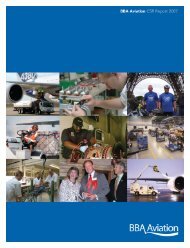Annual Report 2010 in PDF - BBA Aviation
Annual Report 2010 in PDF - BBA Aviation
Annual Report 2010 in PDF - BBA Aviation
Create successful ePaper yourself
Turn your PDF publications into a flip-book with our unique Google optimized e-Paper software.
F<strong>in</strong>ancial statements<br />
85 Independent Auditor’s<br />
<strong>Report</strong> to the Members of<br />
<strong>BBA</strong> <strong>Aviation</strong> plc <strong>in</strong> Respect<br />
of the Consolidated<br />
F<strong>in</strong>ancial Statements<br />
86 Consolidated Income<br />
Statement<br />
87 Consolidated Statement of<br />
Comprehensive Income<br />
88 Consolidated Balance Sheet<br />
89 Consolidated Cash Flow<br />
Statement<br />
90 Consolidated Statement of<br />
Changes <strong>in</strong> Equity<br />
91 Account<strong>in</strong>g Policies of<br />
the Group<br />
95 Notes to the Consolidated<br />
F<strong>in</strong>ancial Statements<br />
126 Independent Auditor’s<br />
<strong>Report</strong> to the Members of<br />
<strong>BBA</strong> <strong>Aviation</strong> plc <strong>in</strong> Respect<br />
of the Parent Company<br />
F<strong>in</strong>ancial Statements<br />
127 Company Balance sheet<br />
128 Account<strong>in</strong>g Policies of<br />
the Company<br />
129 Notes to the Company<br />
F<strong>in</strong>ancial Statements<br />
134 Pr<strong>in</strong>cipal Subsidiary<br />
Undertak<strong>in</strong>gs<br />
135 Five Year Summary<br />
136 Shareholder Information<br />
94 — Consolidated F<strong>in</strong>ancial Statements<br />
Account<strong>in</strong>g Policies – cont<strong>in</strong>ued<br />
Leases<br />
Where assets are fnanced by lease agreements that give rights similar<br />
to ownership (fnance leases), the assets are treated as if they had been<br />
purchased and the leas<strong>in</strong>g commitments are shown as obligations to<br />
the lessors. The capitalisation values of the assets are written of on a<br />
straight-l<strong>in</strong>e basis over the shorter of the periods of the leases or the<br />
useful lives of the assets concerned. The capital elements of future<br />
leases are recorded as liabilities, while the <strong>in</strong>terest elements are<br />
charged to the <strong>in</strong>come statement over the period of the leases to<br />
produce a constant rate of charge on the balance of capital payments<br />
outstand<strong>in</strong>g.<br />
For all other leases (operat<strong>in</strong>g leases) the rental payments are<br />
charged to the <strong>in</strong>come statement on a straight-l<strong>in</strong>e basis over the lives<br />
of the leases.<br />
Inventory<br />
Inventory is stated at the lower of cost and net realisable value.<br />
Cost comprises the cost of raw materials and an appropriate<br />
proportion of labour and overheads <strong>in</strong> the case of work <strong>in</strong> progress<br />
and fnished goods. Cost is calculated us<strong>in</strong>g the frst <strong>in</strong> f rst out<br />
method <strong>in</strong> the Flight Support segment, and weighted average<br />
method <strong>in</strong> the Aftermarket Services and Systems segment. Provision is<br />
made for slow mov<strong>in</strong>g or obsolete <strong>in</strong>ventory as appropriate.<br />
Taxation<br />
The charge for taxation is based on the proft for the year and takes<br />
<strong>in</strong>to account taxation deferred due to temporary dif erences between<br />
the treatment of certa<strong>in</strong> items for taxation and account<strong>in</strong>g purposes.<br />
Current tax is calculated at tax rates which have been enacted or<br />
substantially enacted at the balance sheet date.<br />
Deferred tax is the tax expected to be payable or recoverable on<br />
diferences between the carry<strong>in</strong>g amounts of assets and liabilities <strong>in</strong><br />
the fnancial statements and the correspond<strong>in</strong>g tax bases <strong>in</strong> the<br />
computation of taxable proft, and is accounted for us<strong>in</strong>g the balance<br />
sheet liability method.<br />
No provision is made for temporary dif erences on unremitted<br />
earn<strong>in</strong>gs of foreign subsidiaries, jo<strong>in</strong>t ventures or associates where the<br />
Group has control and the reversal of the temporary diference is not<br />
foreseeable.<br />
The carry<strong>in</strong>g amount of deferred tax assets is reviewed at each<br />
balance sheet date and reduced to the extent that it is no longer<br />
probable that suf cient taxable profts will be available to allow all or<br />
part of the asset to be recovered.<br />
Deferred tax is calculated at tax rates which have been enacted<br />
or substantially enacted at the balance sheet date and that are<br />
expected to apply <strong>in</strong> the period when the liability is settled or the asset<br />
is realised. Deferred tax is charged or credited <strong>in</strong> the <strong>in</strong>come<br />
statement, except when it relates to items charged or credited to<br />
equity, <strong>in</strong> which case the deferred tax is also dealt with <strong>in</strong> equity.<br />
Critical Account<strong>in</strong>g Judgements and Key Sources of Estimation<br />
Uncerta<strong>in</strong>ty<br />
The key assumptions concern<strong>in</strong>g the future, and other key sources of<br />
estimation uncerta<strong>in</strong>ty at the balance sheet date, that have a<br />
signifcant risk of caus<strong>in</strong>g a material adjustment to the carry<strong>in</strong>g<br />
amounts of assets and liabilities with<strong>in</strong> the next fnancial year, are<br />
discussed below. The judgements used by management <strong>in</strong> the<br />
application of the Group’s account<strong>in</strong>g policies <strong>in</strong> respect of these<br />
key areas of estimation are considered to be the most signifcant.<br />
Impairment of goodwill, <strong>in</strong>tangible and tangible f xed assets<br />
Determ<strong>in</strong><strong>in</strong>g whether goodwill, <strong>in</strong>tangible or tangible fxed assets are<br />
impaired requires an estimation of the value <strong>in</strong> use of the cashgenerat<strong>in</strong>g<br />
units to which the goodwill has been allocated or the<br />
<strong>in</strong>dividual assets. The value <strong>in</strong> use calculation requires the entity to<br />
estimate future cash fows expected to arise from the cash-generat<strong>in</strong>g<br />
unit or asset and a suitable discount rate <strong>in</strong> order to calculate present<br />
value. The carry<strong>in</strong>g amount of goodwill, <strong>in</strong>tangible and tangible fxed<br />
assets at the balance sheet date was £485.0 million, £95.0 million and<br />
£327.5 million respectively. Details regard<strong>in</strong>g the goodwill and<br />
tangible fxed asset carry<strong>in</strong>g value and assumptions used <strong>in</strong> carry<strong>in</strong>g<br />
out the impairment reviews are provided <strong>in</strong> notes 8 and 9.<br />
Pensions and other post-retirement benef ts<br />
Determ<strong>in</strong><strong>in</strong>g the present value of future obligations of pension and<br />
other post-retirement beneft schemes requires an estimation of<br />
future mortality rates, future changes <strong>in</strong> employee benefts and length<br />
of service. These assumptions are determ<strong>in</strong>ed <strong>in</strong> association with<br />
qualifed actuaries. The net pension liability related to def ned benef t<br />
type schemes at the balance sheet date was £34.1 million. Details<br />
regard<strong>in</strong>g the carry<strong>in</strong>g value and assumptions used <strong>in</strong> arriv<strong>in</strong>g at the<br />
carry<strong>in</strong>g values are provided <strong>in</strong> note 19.<br />
Taxation<br />
As part of the process for prepar<strong>in</strong>g the Group’s f nancial statements,<br />
management is required to calculate <strong>in</strong>come tax accruals. This process<br />
<strong>in</strong>volves estimates of the current tax exposures together with assess<strong>in</strong>g<br />
temporary diferences result<strong>in</strong>g from difer<strong>in</strong>g treatment of items for<br />
tax and account<strong>in</strong>g purposes. These diferences result <strong>in</strong> deferred tax<br />
assets and liabilities, which are <strong>in</strong>cluded <strong>in</strong> the balance sheet.<br />
As at 31 December <strong>2010</strong>, the Group had a corporate tax liability<br />
of £50.3 million (2009: £45.6 million). While the Group aims to ensure<br />
the accruals for its tax liabilities are accurate, the process of agree<strong>in</strong>g<br />
tax liabilities with the tax authorities can take several years.<br />
Management judgement is therefore required <strong>in</strong> determ<strong>in</strong><strong>in</strong>g the<br />
provision for <strong>in</strong>come tax and the recognition of deferred tax assets and<br />
liabilities; however, the actual tax liabilities could difer from the<br />
amounts accrued.<br />
As at 31 December <strong>2010</strong>, the Group had a net deferred tax<br />
liability of £42.2 million (2009: £29.9 million).<br />
Provisions<br />
The Group exercises judgement <strong>in</strong> measur<strong>in</strong>g and recognis<strong>in</strong>g<br />
provisions and the exposures to cont<strong>in</strong>gent liabilities related to<br />
pend<strong>in</strong>g litigation or other outstand<strong>in</strong>g claims subject to negotiated<br />
settlement, mediation, arbitration or government regulation, as well as<br />
other cont<strong>in</strong>gent liabilities (see note 25 to the consolidated f nancial<br />
statements). Judgement is necessary <strong>in</strong> assess<strong>in</strong>g the likelihood that a<br />
pend<strong>in</strong>g claim will succeed, or a liability will arise, and to quantify the<br />
possible range of the fnancial settlement. Because of the <strong>in</strong>herent<br />
uncerta<strong>in</strong>ty <strong>in</strong> this evaluation process, actual losses may be dif erent<br />
from the orig<strong>in</strong>ally estimated provision.




